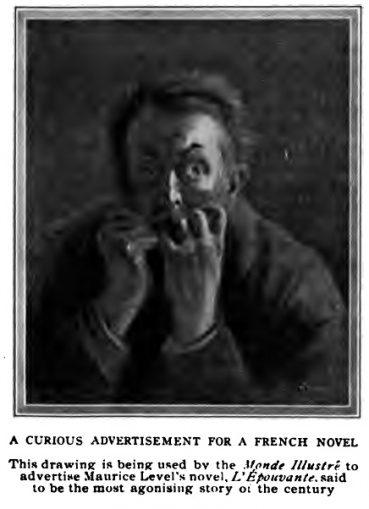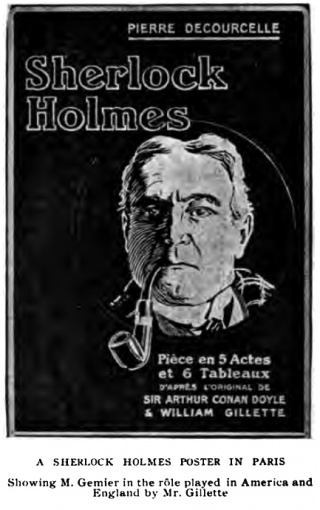French Sherlockitis
French Sherlockitis is an article published in The Bookman (US version p. 6-7) in september 1908.
Photos
- Photos in The Bookman (september 1908)
-
SOME FRENCH SHERLOCK HOLMES COVERS
-
A CURIOUS ADVERTISEMENT FOR A FRENCH NOVEL. This drawing is being used by the Monde illustré to advertise Maurice Level's novel, L'Épouvante, said to be the most agonising story of the century.
-
A SHERLOCK HOLMES POSTER IN PARIS. Showing M. Gemier in the rôle played in America and England by Mr. Gillette.
French Sherlockitis


We wonder whether the new series of Sherlock Holmes stories which is just beginning in Collier's Weekly has not been in a measure inspired by the very remarkable triumph which our old friend has been enjoying in France during the past twelve months. Theoretically, at least — that is to say in the eyes of his professional colleague, M. Dubugue of the Paris Police Secret — Sherlock Holmes has been for years a great personage, and a man worthy of monumental admiration. Practically, however, his French fame has been entirely a matter of recent months. But if the French were characteristically late in discovering him they have shown a characteristic enthusiasm that quite makes up for the long neglect. Paris has what may be described as a bad case of "Sherlockitis." Every other boulevard flaneur considers himself a Sherlock Holmes and goes about applying the science of deduction to the little problems of his daily life. Holmes's popularity is by no means pleasing to the Paris police. Whenever a crime is committed the aver,age Parisian informs his neighbour that Sherlock Holmes would have found the culprit in half a day, and draws comparisons that are uncomplimentary to the French service. In connection with two recent sensational murders the Paris newspapers have been giving their versions of how these crimes were committed in the form of imaginary interviews with Sherlock Holmes. A short time ago a servant stole from his employers a box containing jewels to the value of two thousand francs. He concealed the booty in a hole in the ground in the Bois de Boulogne. When confession was wrung from him he declared that he had been so impressed by the cleverness of Holmes and the cunning of Moriarty as a criminal that he wished to imitate them and commit theft in a scientific and artistic manner.
We have been reading recently with fresh enjoyment the Sherlock Holmes stories in their French garb. Through half a dozen volumes we followed the old tales, "L'Association des Hommes Roux" (The Red Headed League), "Le Commis d'agent de Change" (The Stock Broker's Clerk), "Le Document Vole" (The Naval Treaty), "Pierre le Noir" (Black Peter), "L'homme a la Levre retroussee" (The Man with the Twisted Lip), "Le Visage Jaune" (The Yellow Face), "L'Entrepreneur de Norwood" (The Norwood Builder) and the rest. There was one title, however, which momentarily puzzled us. What could be "Le Champion qui Manque"? As we turned over the pages it soon became evident that this was no other than The Adventure of the Missing Three Quarter.
The real French triumph of Sherlock Holmes has been his theatrical triumph. For almost a year, on the stage of the Theatre Antoine, M. Gemier has been giving a very striking interpretation of the rôle first played by Mr. William Gillette. It is a somewhat Gallicised Sherlock Holmes that he presents. but still unquestionably Sherlock Holmes. There too may be seen nightly a very creditable Moriarty, and an appropriately phlegmatic "Vatson." While the French version of the play, which is by M. Pierre de Courcelle, follows very closely the lines of the play by Mr. Gillette, some curious liberties have been taken with the names of the characters. Larrahee becomes Orlebarre. Sidney Prince, the little safe cracker, bears the impressive appellation of John Alfred Napoleon Bribb. The heroine in the English version Alice Faulkner, in the French play is Alice Brent.
The only radical departure from the Gillette play made by M. de Courcelle is in the last act. Previous to that the action follows the familiar lines — the home of the Larrabees and the visit of Sherlock Holmes, Moriarty's headquarters, Sherlock Holmes's rooms in Upper Baker Street and the interview between the detective and Moriarty, the Gas Chamber of Upper Swandam Lane (in the French play called La Chambre de Sommeil) and the escape of Holmes and the heroine, and finally, the scene in Dr. Watson's study. Here, however, it is Bribb and not Moriarty who is handcuffed while disguised as a cabman, and M. de Courcelle accounts for the arch villain in an addled act. For this act the playwright has taken "The Adventure of the Empty House," the first story of The Return of Sherlock Holmes. The stage is divided into three parts ; in the centre the street, on the left the room occupied by Sherlock Holmes, and on the right a room in the Empty House. In the dim light of a lamp the figure of Sherlock Holmes is seen in an easy chair facing the window, asleep. Into the room of the Empty House slink Moriarty and one of his men, bent on the detective's destruction. Moriarty's air gun is carefully aimed. "Adieu! Sherlock Holmes !" he says ; there is a sharp click, and the recumbent figure in the chair tumbles to the floor. But Moriarty's moment of triumph is brief. Close to his ear there rings out a well-known voice, and from a side door there springs in Sherlock Holmes, followed by the emissaries of the law. The supposed Sherlock Holmes was merely a dummy.


